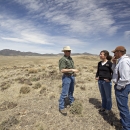The U.S. Fish and Wildlife Service (Service) considers candidate species to be those plants and animals that are candidates for listing under the Endangered Species Act (ESA). These are species for which we have enough information regarding their biological status and threats to propose them as threatened or endangered, but listing is currently precluded by higher priority listing activities. Candidate species are not subject to the legal protections of the ESA. Proactive conservation efforts for these species can, in some cases, eliminate the need to list them under the ESA.
Implementing conservation efforts before species are listed and their habitats become highly imperiled increases the likelihood that simpler, more cost-effective conservation options are available, and that conservation efforts will succeed. In addition, through early conservation efforts, resource managers and property owners have more flexibility to manage their resources in using their land.
Early conservation efforts for declining species can be greatly expanded through collaborative approaches that foster cooperation and exchange of ideas among multiple parties. One of the principal ways of identifying appropriate conservation efforts is through the development of a Candidate Conservation Agreement (CCA).
What is a CCA?
A CCA is a formal, voluntary agreement between the Service and one or more parties to address the conservation needs of candidate species or species that may become candidates in the near future. Participants voluntarily commit to implement specific actions designed to remove or reduce threats to the covered species. The degree of detail in CCAs can vary widely, and there are no specific permits or assurances associated with them.
The Service has entered into many CCAs over the years, primarily with other federal agencies and states. Local governments, tribes, private landowners, and other entities may also participate. Some CCAs have been so successful that listing the covered species was not necessary.
Who can participate?
Any federal or non-federal landowner and other partners, can voluntarily participate in a CCA.
Current participants include private landowners such as ranchers and farmers, corporations, cities, counties, water and park districts, non-governmental organizations, zoos, aquariums, universities, state wildlife agencies, state transportations agencies, state forestry agencies, tribes, the Army Corps of Engineers, Department of Defense, Bureau of Land Management, Bureau of Reclamation, National Park Service, and U.S. Forest Service.
Participating landowners must agree to implement described actions for a specified period to remove or reduce the threats to the target species. Landowners work with the Service, and with each other when more than one is involved, to design and implement conservation measures.
Process
Step 1 - Contact Field Office
- Landowners or managers interested in working with the Service on a CCA for a candidate species, or a species that may become a candidate in the future, can contact the appropriate field office.
Step 2 - Compile Property Information
- When a conservation agreement is found to be feasible, landowners and the Service work together to compile information about the property or properties, including a map, the current management practices, and the management needs of the species and/or habitat. Any threats to the species on the property are also clearly identified.
- Landowners and the Service identify the voluntary management actions needed to address known threats to the target species. They also determine the duration of the agreement, in order to allow enough time to achieve the desired conservation benefit.
Step 3 - Draft CCA
- Landowners and the Service develop a draft CCA that addresses known threats to the species through specific conservation actions. The CCA also describes the current and anticipated management of the property (farming, ranching, timber management, etc.). Additionally, it describes how to monitor the prescribed management actions.
Step 4 - Submit CCA
- Landowners submit the completed CCA to the Service and all parties sign the agreement.
- Landowners begin any new conservation actions and/or continue with existing practices, as identified in the CCA, and reports annually on the agreement’s progress.

